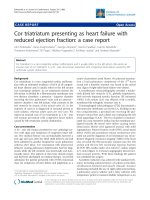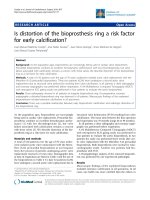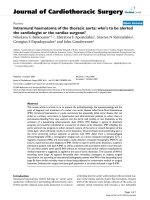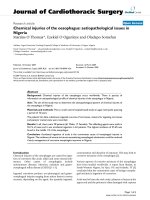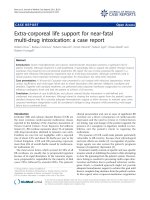Báo cáo y học: " Solid variant of aneurysmal bone cyst of the thoracic spine: a case report" ppsx
Bạn đang xem bản rút gọn của tài liệu. Xem và tải ngay bản đầy đủ của tài liệu tại đây (2.01 MB, 6 trang )
CASE REPO R T Open Access
Solid variant of aneurysmal bone cyst of the
thoracic spine: a case report
George Al-Shamy
1
, Katherine Relyea
1
, Adekunle Adesina
2
, William E Whitehead
1
, Daniel J Curry
1
,
Thomas G Luerssen
1
and Andrew Jea
1*
Abstract
Introduction: The solid variant of aneurysmal bone cyst is rare, and only 13 cases involving the spine have been
reported to date, including seven in the thoracic vertebrae. The diagnosis is difficult to secure radiographically
before biopsy or surgery.
Case report: An 18-year-old Hispanic man presented to our facility with a one-year history of left chest pain
without any significant neurological deficits. An MRI scan demonstrated a 6 cm diameter enhancing multi-cystic
mass centered at the T6 vertebral body with involvement of the left proximal sixth rib and extension into the
pleural cavity; the spinal cord was severely compressed with evidence of abnormal T2 signal changes. Our patient
was taken to the operating room for a total spondylectomy of T6 with resection of the left sixth rib from a single-
stage posterior-only approach. The vertebral column was reconstructed in a 360° manner with an expandable
titanium cage and pedicle screw fixation. Histologically, the resected specimen showed predominant solid
fibroblastic proliferation, with minor foci of reactive osteoid formation, an area of osteoclastic-like gian t cells, and
cyst-like areas filled with erythrocytes and focal hemorrhage, consistent with a predominantly solid variant of
aneurysmal bone cyst. At 16 months after surgery, our patient rema ins neurologically intact with resolution of his
chest and back pain.
Conclusions: Because of its rarity, location, and radical treatment approach, we considered this case worthy of
reporting. The solid variant of aneurysmal bone cyst is difficult to diagnose radiologically before biopsy or surgery,
and we hope to remind other physicians that it should be included in the differential diagnosis of any lytic
expansile destructive lesion of the spine.
Introduction
Aneurysmal bone cyst is an expansile, non-neoplastic
tumor-like lesion, commonly occurring around the knee
and, rarely, in the vertebral column. Histologically, aneur-
ysmal bone cyst is typically characteri zed by cavernous
channels surrounded by a spindle cell stroma with osteo-
clast-like giant cells and osteoid production [1]. There is a
distinct solid variant of aneurysmal bone cyst, first
described by Sanerkin et al. [2] in 1983; the authors
described four cases of an unusual intra-osseous fibroblas-
tic lesion with scattered osteoclastic, osteoblastic, fibro-
myxoid elements, without a predominant component of
cavernous channels. This solid variant may be easily mis-
diagnosed as a spindle cell tumor, especially osteosarcoma
[3]. It is a rare lesion, accounting for 3.4% t o 7.5% of all
aneurysmal bone cysts [3], and only 13 cases [3,4] occur-
ring in the spine have been previously reported. These
cases have almost exclusively involved the pediatric age
group, ranging in age from six to 17 years. Alt hough the
solid variant of aneurysmal bone cyst has the same biologi-
cal nature as conventional aneurysmal bone cyst, the two
forms differ in MRI scan findings.
We report a case of the solid variant of aneurysmal
bonecystoccurringintheT6vertebrawithextensive
involvemen t of the left sixth rib and pleural cavity in an
18-year -old Hispanic man. We review the 13 prior cases
that have been reported in the literature and discuss the
unique features of these unusual tumor-like lesions of
the vertebral column.
* Correspondence:
1
Neuro-Spine Program, Division of Pediatric Neurosurgery, Texas Children’s
Hospital, Department of Neurosurgery, Baylor College of Medicine, Houston,
TX, USA
Full list of author information is available at the end of the article
Al-Shamy et al. Journal of Medical Case Reports 2011, 5:261
/>JOURNAL OF MEDICAL
CASE REPORTS
© 2011 Al-Shamy et al; licensee BioMed Central Ltd. This is an Open Access article distributed under the terms of the Creative
Commons Attri bution License ( which permits unrestricted use, distribution, and
reproductio n in any medium, provided the original work is properly cited.
Case presentation
An 18-year-old, previously healthy Hispanic man pre-
sented to our institutio n with a one-year history of left
paraspinal tenderness and radiation into the left chest.
Our patient deni ed weakness or numbness of the legs
and bowel or bladder incontinence. He had no difficul-
ties with ambulation or balance.
On physical examinati on, tenderness could be elic ited
on palpation of the spinous processes of the mid-thor-
acic spine. No motor or sensory deficits were observed.
There were no signs of myelopathy. A rec tal examina-
tion showed good volitional rectal tone and no perineal
anesthesia. The post-void residual volume of urine was
negligible.
A computed tomography (CT) scan of the thoracic
spine (Figure 1) demonstrated an expansile oste olytic
lesion occupying the left part of the vertebral body of
T6 destroying the lamina and pedicle as well as the
associated rib at that level. MRI of the thoracic spine
(Figure 2) revealed a large hypointense lesion on T1-
weighted images with homogenous enhancement. The
lesion showed mixed low -signal int ensity with scattered
high-signal intensity areas on T2-weighted MRI, sug-
gesting microcysts.
Consideration was given to pre-operative spinal angio-
graphy and possible embolization of large arterial fee-
ders to the mass. However, the risk of spinal cord
infar ction with embolization was deemed to be too high
by the experienced interventional radiologists at our
institution, and subsequently, this was not performed.
Our patient was taken to the operating room where a
single stage posterior-only approach for total T6 spondy-
lectomy with left sixth rib removal and circumferential
reconstruction of vertebral column was planned (Figure
3). Spinal cord monitoring was performed with motor
Figure 1 Pre-operative axial computed tomography (CT)
windowed for bone at the level of T6 shows an osteolytic and
expansile lesion predominantly involving the left vertebral
body, posterior elements, and proximal rib with a large intra-
thoracic soft tissue component.
A
B
C
Figure 2 Pre-operative axial ( A) T1-w eighted a nd (B) T2-
weighted MRI demonstrate a large heterogeneous low and
high signal intensity mass lesion involving T6. (C) Enhanced T1-
weighted MRI shows a more homogenous high signal T6 mass.
Al-Shamy et al. Journal of Medical Case Reports 2011, 5:261
/>Page 2 of 6
evoked potentials and somatosensory evoked potentials. A
midline incision was made and a limb of the incisio n was
extended toward the left, centered over T6 to provide a
lateral extracavitary exposure. A T4 to T8 laminectomy
was performed. Pedicle screws were placed at T4, T5, T7,
and T8. After placing a temporary rod on the right side,
the resection of the left sixth rib, mass lesion, and vertebral
body of T6 proceeded in a piecemeal fashion. A section of
parietal pleura was resected along with the tumor; there
was no plane of separation between tumor capsule and
pleura. A 13 mm diameter, 4° angle titanium expandable
inter-body spacer spanned the T6 defect. An attempt was
made to reduce the pre-operative kyphosis of 24° by com-
pression between the pedicle screws at T5 and T7; how-
ever, there was a transient loss of motor evoked responses
when this was performed. Therefore, the spine was fu sed
in situ with no further attempts at correction of the
kyphosis. Morselized bone graft from the osteotomized
laminae and cancellous morselized allograft were used as
graft material.
Post-operatively, our patient was neurologically intact.
However, he did develop a pleural effusion on the left
side on the first post-operative day that necessitated
chest tube placemen t. The effusion was likely from irri-
tation of the pleura and post-operative oozing of fluid/
blood from the operative bed directly into the pleural
cavity. There was no hematoma, and there were no
signs of infection. After the chest tube was removed two
days later, our patient progressed quickly in his recovery
from surgery and was subsequently discharged home.
Imaging revealed gross total resection of the mass
lesion, adequate screw placement and moderate kypho-
sis of 34° (Figure 4). At 16 months after surgery our
patient continues to do well and to be sa tisfied with the
surgery, remaining pain free and neurologically intact
and attaining radiological bony fusion without evidence
of tumor recurrence.
Frozen and permanent sections (Figure 5) showed a
predominantly solid lesion with frequent giant cells. The
surrounding tissues included skeletal muscle, adipose
tissue, and nerve bundles. The lesion c onsisted of oval
to slightly spindled stromal cells interspersed with
multi-nucleated osteoclast-like giant cells. There were
areas of hemosiderin deposition, calcification, and reac-
tive bone formation within the mass. Cyst-like areas
filled with erythrocytes and areas of hemorrhage were
also noted focally. No cytological atypia or brisk mitotic
activity was appreciated. There was no evidence of
malignancy. The histopathological feat ures were consis-
tent with those of a predominantly solid variant of
aneurysmal bone cyst.
Discussion
Aneurysmal bone cysts predominantly afflict children,
with 60% of patients being younger than 20 years old;
the peak incidence is d uring the second decade of life,
and there is a slight preponderance for women over
men [5,6]. In the same review of 94 cases by Hay et al.
[6], the cervical spine was involved in 22% of cases, the
thoracic spine i n 34%, the lumbar spine in 31%, and the
sacrum in 13%.
Bertoni et al. [3] reviewed 15 cases of the solid variant
of aneurysmal bone cyst. The authors reported that the
patient age distribution was two to 49 years (mean 23
years) and the male:female ratio was 1:1.5. The femur
and tibia were the most commonly affected sites, and
the spine was rarely affected.
Our review of 14 cases, including our patient, of spinal
involvement of the solid variant of aneurysmal bone cyst
is summarized in Table 1. The age of patients ranged
from six to 18 years (mean, 11.4 years), and the m ale:
female ratio was 1:1.8. More than half of the cases
occ urred in the thoracic spine. The cervica l and lumbar
vertebrae were involved in three cases each. Neck, back,
or chest pain was the most common complaint on pre-
sentation. On average, symptoms persist for 12 months
Figure 3 Artist’ s illustration of the single stage posterior-only
approach for resection of the tumor, left sixth rib, and T6
vertebral body with circumferential reconstruction of the
spinal column.
Al-Shamy et al. Journal of Medical Case Reports 2011, 5:261
/>Page 3 of 6
before definitive diagnosis. Conventional aneurysmal
bone cyst of the vertebral column typically origi nates in
the posterior neural arch and expands unilaterally to
produce an eccentric paravertebral lesion [6]. In some
cases of conventio nal aneurysmal bone cyst, destruction
of the vertebral bodies with partial or complete collapse
occurs.
The routine radiographic features on plain radiographs
and CT of the solid variant of aneurysmal bone cyst
include an osteolytic and expansile lesion that is i ndis-
tinguishable from c onventional aneurysmal bone cyst.
Like conventional aneurysmal bone cysts, almost all
cases reviewed of the solid variant ane urysmal bone cyst
originated from the posterior elements of the vertebra.
Involvement of the vertebral body, as in our patient, was
rare and was reported in only two prior cases.
Similar to conventional aneurysmal bone cysts, MRI of
the solid variant of aneurysmal bone cyst revea ls homo-
geneous low-signal intensity on T1-weighted images and
heterogeneous low-signal intensity with scattered high-
signal intensity areas on T2-weighted images with possi-
ble fluid-fluid levels. This feature is very characteristic
and highly suggestive of the diagnosis of aneurysmal
bone cyst. In conventional aneurysmal bone cyst, thin,
smooth septations of the lesion are seen in T1-weighted
or T2-weighted images with contrast whereas enhanced
MRI scans of the solid variant show more homogenous
high signal intensity throughout the lesion. This is per-
haps a distinguishing characteristic of solid aneurysmal
bone cyst from conventional aneurysmal bone cyst.
Although these t umors are benign and spontaneous
regression has been rarely described, prompt surgery
appears to be the mainstay of treatment especially in
cases of neurological compromise from nerve root or
spinal cord compression, despite the lack of clear treat-
men t guidelines. Most patients in our revi ew were trea-
ted by a conservative attempt at curettage because of
A
B
Figure 4 Post-operative standing thoracic spine X-rays (A) AP
and (B) lateral shows an expandable titanium cage filling T6
spondylectomy defect and posterior pedicle screw fixation.
Figure 5 Photomicrographs (A) (×100) and (B) (×200) illustrate
the proliferating round to oval cells mixed with randomly
distributed multi-nucleated giant cells. Regions of reactive
fibroblastic proliferation are present. Panels (C) (×200) and (D)
(×400) show an example of region of tumor with the blood filled
microcystic component.
Al-Shamy et al. Journal of Medical Case Reports 2011, 5:261
/>Page 4 of 6
the benign character of these spinal lesions, although a
higher rate of recurrence of up to 30% may develop
after curettage [6]; therefore, the surgical goal should be
a complete marginal excision. Radiation therapy was
undertaken in two cases; repor ts of late post-irradiation
sarcomas and post-irradiation myelopathy in patients
with conventional ane urysmal bone cyst have made
other authors more cautious about its use, and adjuvant
radiation therapy should be reserved for patients with
inoperable lesions because of location or associated
medical conditions, or aggressive recurrent disease.
Intra-cystic sclerosant injections, while favored in other
locations, have resulted in mortality and major
morbidities when used in the spine [7]. Embolization of
feeding segmental arteries has been proposed as a pre-
operative adjunct or sole tre atment for aneurysmal bone
cysts [8,9]; however, embolization as the sole mode of
therapy has very limited applicat ions in the spine, espe-
cially in the setting of pathological fracture and neurolo-
gical compromise. In addition, embolization of multiple
small feeding vessels is technically difficult, and inadver-
tent embolization of segmental arteries to the spinal
cord may result in spinal cord in farction. Despite these
concerns, t he literature [10] suggests angiography and
embolization can be performed without a significant risk
of permanent neurological deficit, skin, or muscle
Table 1 Previous reports of solid variant of aneurysmal bone cyst of the spine (modified from Suzuki et al. [10])
Ref. Age Sex Site
of
lesion
Presenting
signs and
symptoms
Radiological findings Treatment Follow-
up
Outcome
[2] 7 M L4 Back pain,
swelling, and
abnormal gait
Expansile cystic lesion in L4
lamina
Tumor shelled out, laminectomy six
years
No recurrence
[2] 6 F T2 Back pain
and palpable
tender mass
Destruction of lamina of T2 Partial piecemeal removal,
laminectomy followed by irradiation
(1.5 Gy)
one
year
Residual mass
[2] 13 M T7 Back pain,
scoliosis, and
myelopathy
Destruction of lamina of T7
with paravertebral mass
Subtotal excision, laminectomy,
followed by irradiation (1.5 Gy)
three
years
Recurrence at 6
months treated by
curettage and bone
graft with no
recurrence for 3 years
[4] 10 F C1 Pain and
swelling
[7] 17 F T1 Radiculopathy Expansile lytic lesion in T1
lamina and spinous process
Subtotal excision, laminectomy one
year
No recurrence
[7] 16 F T7 Back pain Lytic lesion in T7 lamina and
transverse process
Curettage and bone graft, irradiation
(5 Gy)
eight
years
No recurrence
[8] 9 F L3 Back pain Expansile osteolytic lesion in
vertebral body, pedicle,
transverse process, and lamina
Irradiation (20 Gy) six
years
No recurrence
[3] 14 F C7 Neck pain Expansile lytic lesion in spinous
process of C7 and kyphotic
deformity
N/A N/A N/A
[3] 8 M L5 Radiculopathy Expansile cystic lesion in L5
lamina and soft tissue mass
causing L5 root compression
N/A N/A N/A
[3] 6 F T2 Back pain Destructive lytic lesion in T2
lamina and small rim of cortex
in left paravertebral area
N/A N/A N/A
[3] 14 M T7 Back pain Destructive lytic lesion in T7
pedicle
N/A N/A N/A
[6] 12 F T3-4 Back pain Lytic lesion with destruction of
neural arch
Excision and complete curettage three
years
No recurrence
[5] 9 F C4 Neck pain Expansile lytic lesion in C4
lamina and kyphotic deformity
Laminectomy, curettage followed by
C2-5 fusion
one
year
No recurrence
Our
patient
18 M T6 Chest pain Expansile lytic lesion of T6
vertebral body, left pedicle,
and lamina, and left sixth rib
with soft tissue mass in left
pleural cavity
Total spondylectomy T6 with left
sixth rib resection and resection of
intra-pleural soft tissue mass;
circumferential reconstruction of
vertebral column
16
months
No recurrence
Al-Shamy et al. Journal of Medical Case Reports 2011, 5:261
/>Page 5 of 6
necrosis. However, in our case, the experienced inter-
ventional neuroradiologists at our institution deemed
the risk higher than usual given the proximity of the
feeding artery to the tumor and the a nterior spinal
artery, combined with the watershed location at T6.
Depending on the proliferative c omponent, the solid
variant of aneurysmal bone cyst may be histologically
misdiagnosed for other benign and malignant and
tumor-like lesions of the bone. The pathological differ-
ential diagnosis includes solitary bone cyst, hemangioma,
osteosarcoma, giant cell tumor, and chondroblastoma.
Conclusions
Our patient w as treated with an aggressive posterior-
only surgical approach for complete resection of the
aneurysmal bone cyst and circumferential reconstruction
of the vertebral column with preservation of neurologi-
cal function. Whether an aggressive surgical approach
results in a better outcome and recurrence ra te than a
more conservative one (for example, curettage alone)
remains to be seen in longer-term follow-up, and is the
subject of future studies.
Consent
Written informed consent was obtained from the patient
for publicatio n of this case report and any accompany-
ing images. A copy of the written consent is available
for review by the Editor-in-Chief of this journal.
Acknowledgements
We would like to recognize Lily Chun for her editorial assistance in the
production of this manuscript.
Author details
1
Neuro-Spine Program, Division of Pediatric Neurosurgery, Texas Children’s
Hospital, Department of Neurosurgery, Baylor College of Medicine, Houston,
TX, USA.
2
Department of Pathology, Texas Children’s Hospital, Baylor College
of Medicine, Houston, TX, USA.
Authors’ contributions
GA was responsible for the concept and design of the manuscript and for
writing and editing of the manuscript. KR aided in the illustration of the
manuscript. AA analyzed and interpreted the pathological data for our
patient. WEW aided in the editing of the manuscript. DJC aided in the
editing of the manu script. TGL aided in the editing of the manuscript. AJ
was responsible for the concept and design of the manuscript and for
writing and/or editing the manuscript. All authors read and approved the
final manuscript.
Competing interests
The authors declare that they have no competing interests.
Received: 9 February 2010 Accepted: 30 June 2011
Published: 30 June 2011
References
1. Rosales-Olivares LM, Baena-Ocampo LDC, Miramontes-Martínez VP, Alipízar-
Aguirre A, Reyes-Sánchez A: Aneurysmal bone cyst of the spine [in
Spanish]. Cir Cir 2006, 74:371-374.
2. Sanerkin NG, Mott MG, Roylance J: An unusual intraosseous lesion with
fibroblastic, osteoclastic, osteoblastic, aneurysmal and fibromyxoid
elements: “solid” variant of aneurysmal bone cyst. Cancer 1983,
51:2278-2286.
3. Bertoni F, Bacchinin P, Capanna R, Ruggieri P, Biagini R, Ferruxxi A,
Bettelli G, Picci P, Campanacci M: Solid variant of aneurysmal bone cyst.
Cancer 1993, 71:729-734.
4. Edel G, Roessner A, Blasius S, Erlemann R: “Solid” variant of aneurysmal
bone cyst. Pathol Res Pract 1992, 188:791-796.
5. Dahlin DC, Unni KK: Bone Tumors. General Aspects and Data on 11,087 Cases.
5 edition. Philadelphia, PA: Lippincott-Raven; 1996, 382-390.
6. Hay MC, Paterson D, Taylor TK: Aneurysmal bone cyst of the spine. J Bone
Joint Surg Br 1978, 60:406-411.
7. Guiband L, Herbreteau D, Dubois J, Stempfle N, Berard J, Pracros JP,
Merland JJ: Aneurysmal bone cysts: percutaneous embolization with an
alcoholic solution of zein - series of 18 cases. Radiology 1998,
208:369-373.
8. De Cristofaro R, Biagini R, Boriani S, Ricci S, Ruggieri P, Rossi G, Fabbri N,
Roversi R: Selective arterial embolization in the treatment of aneurysmal
bone cyst and angioma of bone. Skeletal Radiol 1992, 21:523-527.
9. DeRosa GP, Graziano GO, Scott J: Arterial embolization of aneurysmal
bone cyst of the lumbar spine: a report of two cases. J Bone Joint Surg
(Am) 1990, 72:777-780.
10. Shi HB, Suh DC, Lee HK, Lim SM, Kim DH, Choi CG, Lee CS, Rhim SC:
Preoperative transarterial embolization of spinal tumor: embolization
techniques and results. AJNR Am J Neuroradiol 1999, 20:2009-2015.
11. Suzuki M, Satoh T, Nishida J, Kato S, Toba T, Honda T, Masuda T: Solid
variant of aneurysmal bone cyst of the cervical spine. Spine (Phila Pa
1976) 2004, 29:E376-381.
doi:10.1186/1752-1947-5-261
Cite this article as: Al-Shamy et al.: Solid variant of aneurysmal bone
cyst of the thoracic spine: a case report. Journal of Medical Case Reports
2011 5:261.
Submit your next manuscript to BioMed Central
and take full advantage of:
• Convenient online submission
• Thorough peer review
• No space constraints or color figure charges
• Immediate publication on acceptance
• Inclusion in PubMed, CAS, Scopus and Google Scholar
• Research which is freely available for redistribution
Submit your manuscript at
www.biomedcentral.com/submit
Al-Shamy et al. Journal of Medical Case Reports 2011, 5:261
/>Page 6 of 6

